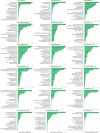Machine learning predicts improvement of functional outcomes in spinal cord injury patients after inpatient rehabilitation
- PMID: 40927746
- PMCID: PMC12414964
- DOI: 10.3389/fresc.2025.1594753
Machine learning predicts improvement of functional outcomes in spinal cord injury patients after inpatient rehabilitation
Abstract
Introduction: Spinal cord injury (SCI) presents a significant burden to patients, families, and the healthcare system. The ability to accurately predict functional outcomes for SCI patients is essential for optimizing rehabilitation strategies, guiding patient and family decision making, and improving patient care.
Methods: We conducted a retrospective analysis of 589 SCI patients admitted to a single acute rehabilitation facility and used the dataset to train advanced machine learning algorithms to predict patients' rehabilitation outcomes. The primary outcome was the Functional Independence Measure (FIM) score at discharge, reflecting the level of independence achieved by patients after comprehensive inpatient rehabilitation.
Results: Tree-based algorithms, particularly Random Forest (RF) and XGBoost, significantly outperformed traditional statistical models and Generalized Linear Models (GLMs) in predicting discharge FIM scores. The RF model exhibited the highest predictive accuracy, with an R-squared value of 0.90 and a Mean Squared Error (MSE) of 0.29 on the training dataset, while achieving 0.52 R-squared and 1.37 MSE on the test dataset. The XGBoost model also demonstrated strong performance, with an R-squared value of 0.74 and an MSE of 0.75 on the training dataset, and 0.51 R-squared with 1.39 MSE on the test dataset. Our analysis identified key predictors of rehabilitation outcomes, including the initial FIM scores and specific demographic factors such as level of injury and prehospital living settings. The study also highlighted the superior ability of tree-based models to capture the complex, non-linear relationships between variables that impact recovery in SCI patients.
Discussion: This research underscores the potential of machine learning models to enhance the accuracy of outcome predictions in SCI rehabilitation. The findings support the integration of these advanced predictive tools in clinical settings to better guide decision making for patients and families, tailor rehabilitation plans, allocate resources efficiently, and ultimately improve patient outcomes.
Keywords: acute rehabilitation; computational modelling; functional outcomes; machine learning; spinal cord injury (SCI).
© 2025 Rasoolinejad, Say, Wu, Liu, Zhou, Zhang, Rosario and Lu.
Conflict of interest statement
The authors declare that the research was conducted in the absence of any commercial or financial relationships that could be construed as a potential conflict of interest. The author(s) declared that they were an editorial board member of Frontiers, at the time of submission. This had no impact on the peer review process and the final decision.
Figures








Similar articles
-
Development of a machine learning model and a web application for predicting neurological outcome at hospital discharge in spinal cord injury patients.Spine J. 2025 Jul;25(7):1483-1493. doi: 10.1016/j.spinee.2025.01.005. Epub 2025 Jan 31. Spine J. 2025. PMID: 39894282
-
Are Current Survival Prediction Tools Useful When Treating Subsequent Skeletal-related Events From Bone Metastases?Clin Orthop Relat Res. 2024 Sep 1;482(9):1710-1721. doi: 10.1097/CORR.0000000000003030. Epub 2024 Mar 22. Clin Orthop Relat Res. 2024. PMID: 38517402 Free PMC article.
-
Development of Machine Learning-based Algorithms to Predict the 2- and 5-year Risk of TKA After Tibial Plateau Fracture Treatment.Clin Orthop Relat Res. 2025 Mar 12;483(9):1731-1743. doi: 10.1097/CORR.0000000000003442. Clin Orthop Relat Res. 2025. PMID: 40106382
-
Rehabilitation following surgery for lumbar spinal stenosis.Cochrane Database Syst Rev. 2013 Dec 9;2013(12):CD009644. doi: 10.1002/14651858.CD009644.pub2. Cochrane Database Syst Rev. 2013. PMID: 24323844 Free PMC article.
-
Multidisciplinary rehabilitation for older people with hip fractures.Cochrane Database Syst Rev. 2021 Nov 12;11(11):CD007125. doi: 10.1002/14651858.CD007125.pub3. Cochrane Database Syst Rev. 2021. PMID: 34766330 Free PMC article.
References
LinkOut - more resources
Full Text Sources

